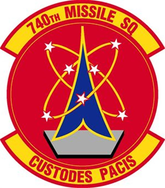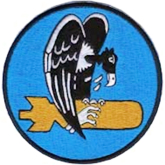740th Missile Squadron
| 740th Missile Squadron | |
|---|---|

LGM-30G Minuteman III test launch at Vandenberg AFB, California
|
|
| Active | 1943-1945; 1947–1949; 1956–1957; 1962–present |
| Country |
|
| Branch |
|
| Type | Squadron |
| Role | Intercontinental ballistic missile |
| Garrison/HQ | Minot Air Force Base, North Dakota |
| Motto(s) | Custodes Pacis Latin Custodians of Peace |
| Engagements |
World War II (EAME Theater) |
| Decorations |
Distinguished Unit Citation (2x) Air Force Outstanding Unit Award (9x) |
| Insignia | |
| 740th Missile Squadron emblem (approved 16 July 1964) |  |
| Unofficial 740th Bombardment Squadron emblem | |
The United States Air Force's 740th Missile Squadron is a missile operations squadron of the 91st Missile Wing, 91st Operations Group, located at Minot Air Force Base, North Dakota.
The 740th missile squadron controls and maintains 50 launch facilities and 5 missile alert facitilies. The squadron is divided into missile operations flights, which are responsible for day-to-day operations, maintenance, and security, and operations support flights, which are responsible for ensuring the readiness of the missile alert facilities.
Established as a B-24 Liberator heavy bombardment unit in mid-1943; assigned to II Bomber Command for training. Primarily trained in New Mexico and Utah received deployment orders for the Mediterranean Theater of Operations (MTO) in November 1943. Moved to Virginia where the group flew long-range convoy escort missions over the Mid-Atlantic, October–November 1943 while station in Italy was being constructed.
Deployed to Southern Italy in January 1944; entered combat in January 1944, being assigned to Fifteenth Air Force. Engaged in very long range strategic bombing missions to enemy military, industrial and transportation targets in Italy, France, Germany, Austria, Hungary, Romania, and Yugoslavia, bombing railroad marshalling yards, oil refineries, airdrome installations, heavy industry, and other strategic objectives.
In addition to strategic missions in the Balkans, the group bombed troop concentrations, bridges, marshalling yards, and airdromes during the fall of 1944 to hamper the enemy’s withdrawal from the region. The group also supported ground forces at Anzio and Cassino in March 1944; knocked out gun positions in preparation for the invasion of Southern France in August 1944; and assisted the final Allied drive through Italy in April 1945 by hitting such targets as bridges, gun positions, and troop concentrations.
...
Wikipedia

